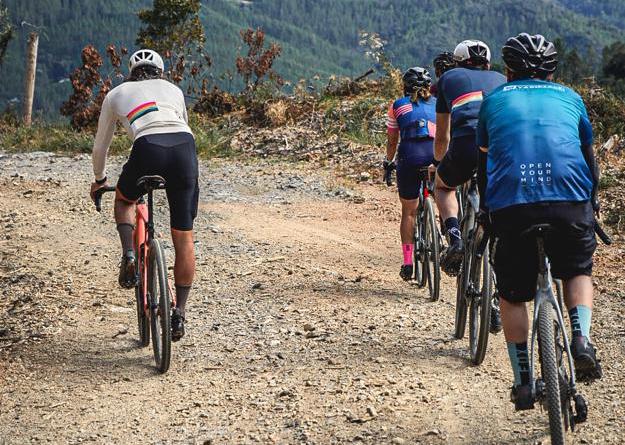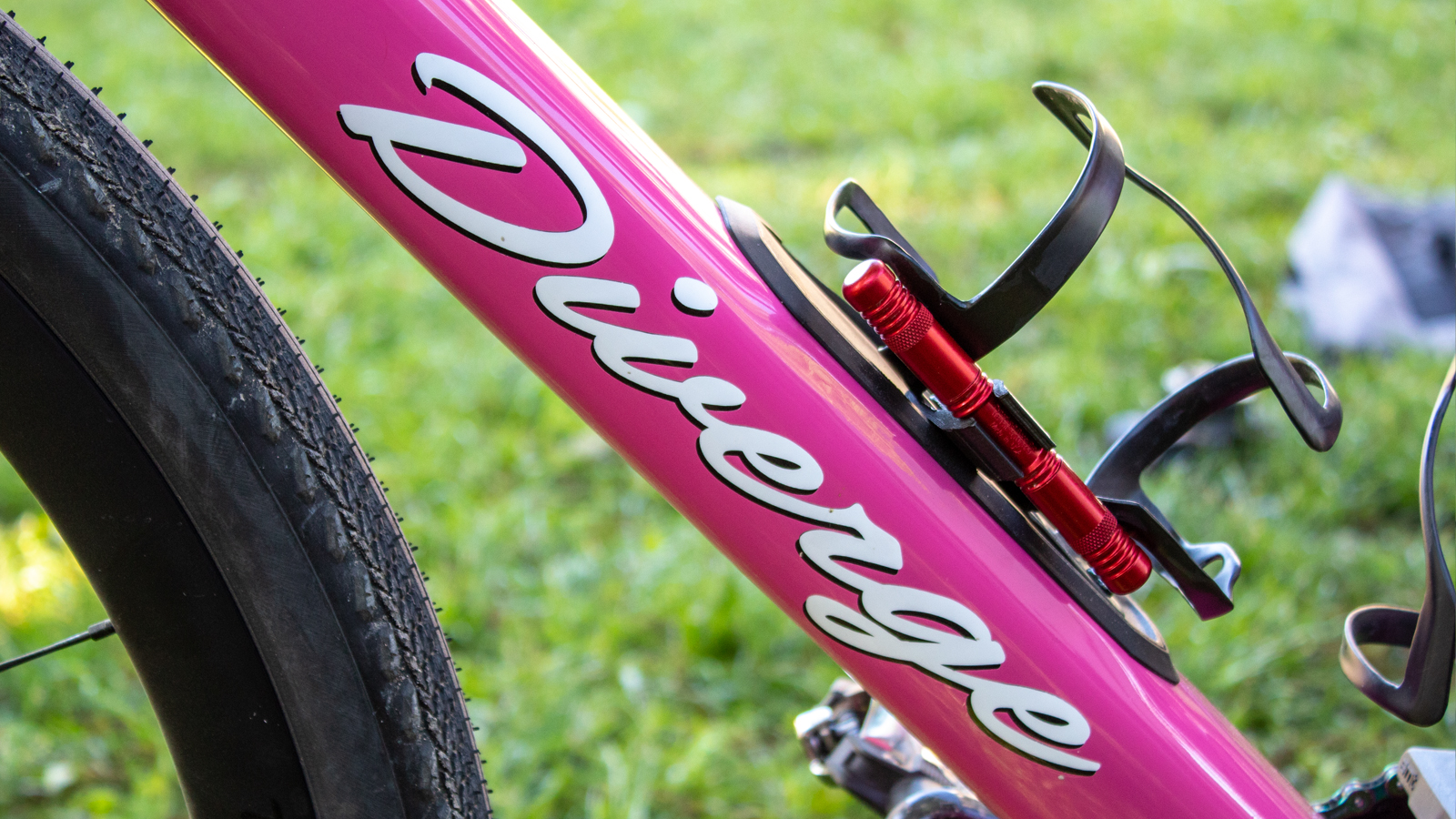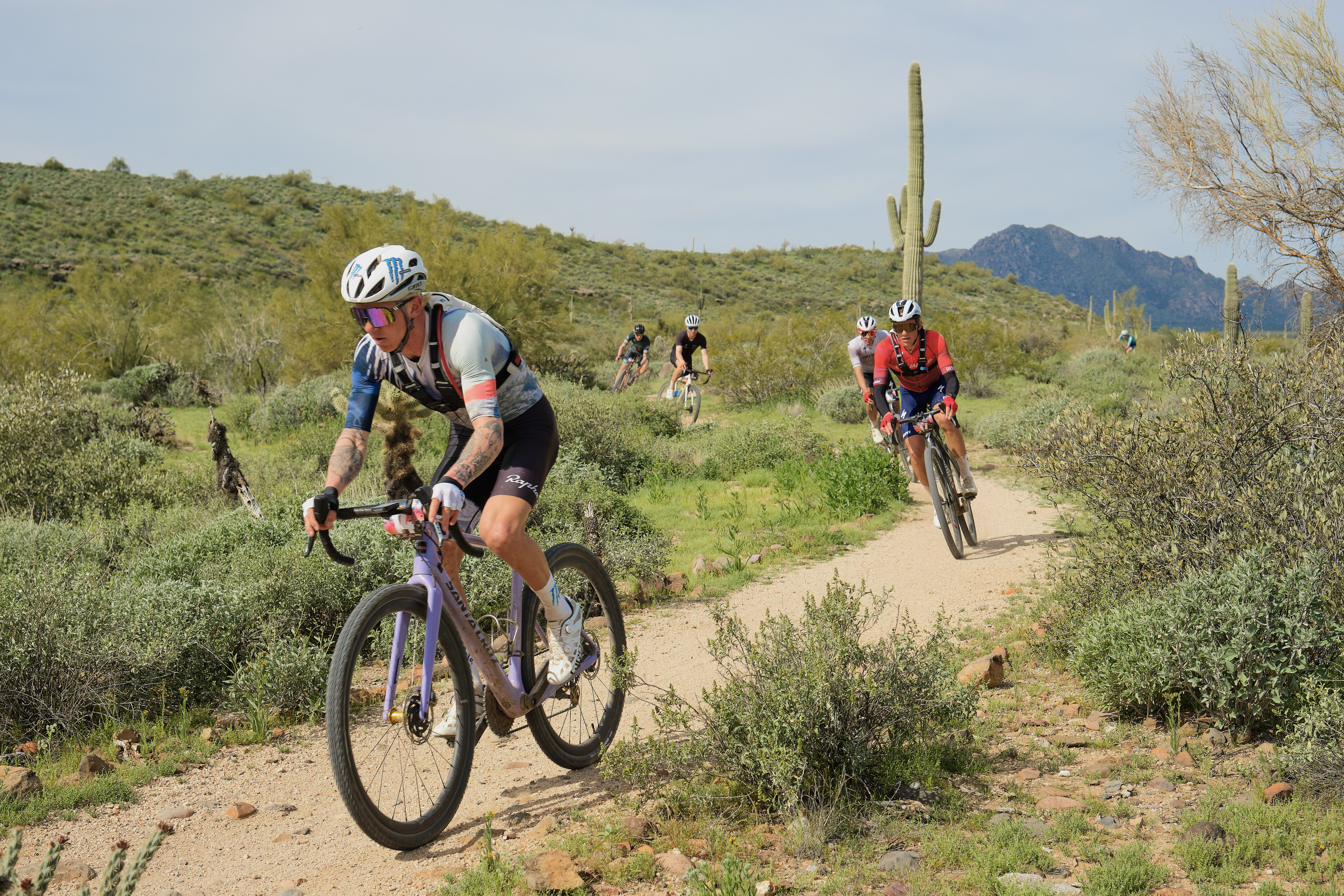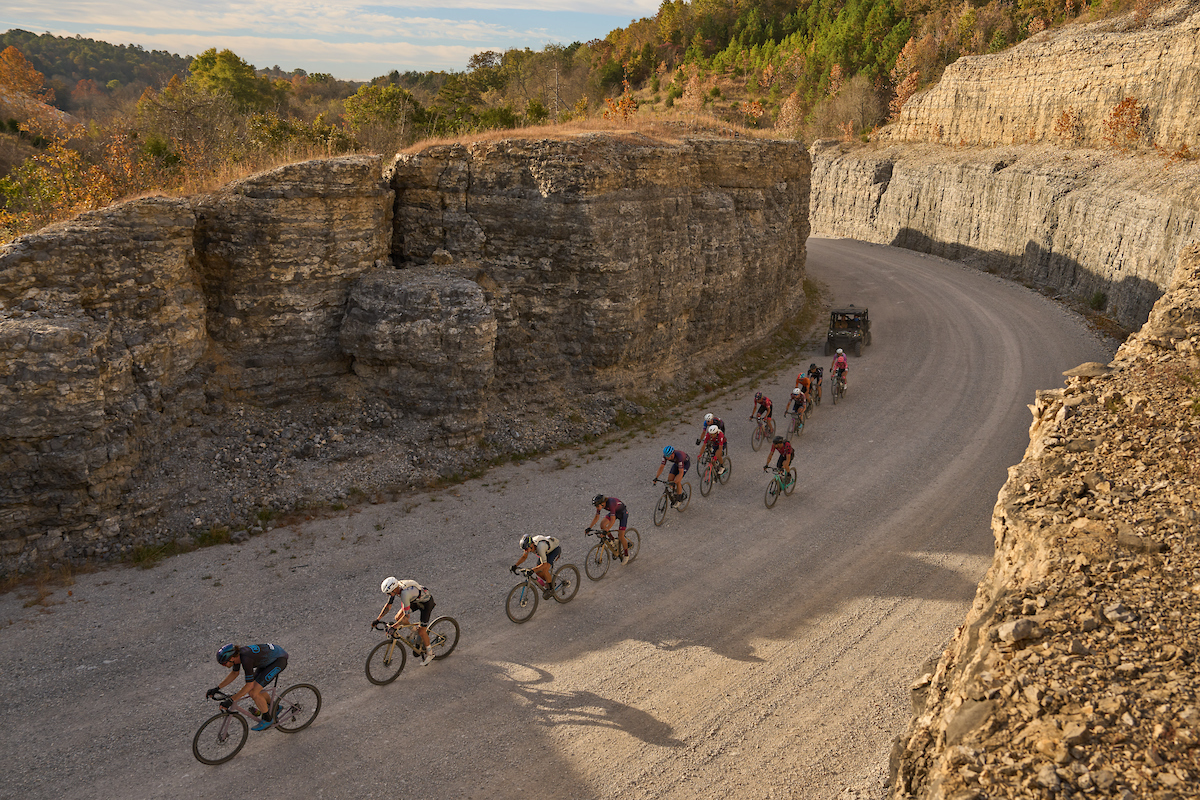What is gravel? How geology dictates tech choices for gravel races
A geologist's look at cycling's undefinable surface, and an inside line on bike setup from Ian Boswell

For a short moment, I’m going to let you be a fly on the wall at a Cyclingnews content meeting. Picture the scene: It’s the best cycling journalists in the game (I was absent, though I decided not to take that as a comment on my professional ability), and we’re thinking about how we’re going to cover Unbound Gravel for 2023:
“Maybe if we found someone with a geology degree we could get them to explain the different kinds of gravel you get at races and how it affects equipment choices?”
It took my editor until the end of the meeting to remember that I have a geology degree, a master's in mining, and 10 years of experience in the mining industry, including a stint in gravel extraction. At that point, he suggested that we might have someone qualified on the team already.
Here we are then. I’m going to give you a crash course in why geology is really what underpins riders' equipment choices for the biggest gravel races of the year. It’s the foundation of every great bike race the world over, from the Flint Hills and rolling roads of Kansas, through the white roads of Tuscany at Strade Bianche, to the monumental climbs in the Alps and the Pyrenees at the Grand Tours.
Because I don’t live in the US, I also enlisted the help of former Unbound winner Ian Boswell, who very kindly gave me his professional opinion on things as someone who is riding these races to win.

What is gravel?
Technically speaking, gravel is simply a size fraction. It can be made of absolutely anything, as long as it’s between 2mm and 60mm in diameter. Beyond this it’s a ‘cobble’, meaning the cobbled roads of Paris-Roubaix are accurately named for the most part. If they stray over 20cm it’s a boulder, but at that point, we’re all thinking MTB, right?
Below gravel, more importantly for most of us, we’ve got sand, silt, and clay. Sand gets down to 0.06mm, and below that, it’s fine enough to start gumming together when wet and really clogging your drivetrain.
The latest race content, interviews, features, reviews and expert buying guides, direct to your inbox!
Why does this matter for your equipment though? The most obvious reason is tyre choice.
Depending on your mix of sand, clay, and actual gravel, you’re going to want different tyre treads, widths, and casings. It’ll dictate to some degree whether you add more sealant too, just in case, or risk it with less. It’ll also dictate gearing; if the landscape has made super steep, punchy climbs then your lowest gear will need to be lower, and conversely if the parcours is pan flat or rolling you can opt for a super tight block at the back and be more comfortable with 1x.
We’re going to stick to US geology here, both to limit the scope (i.e. stop me diverting down too many geological cul de sacs) and because it has a much more thriving gravel race scene.
For Boswell, the term “Gravel” would have been much better off being “Mixed Surface Riding”. I tend to agree, though it’s not got the same snap that marketing departments thrive on. As we’ll see, even within one nation (albeit a big one) the surface is so varied a single catchall term for the surface you ride on does begin to feel a little crazy.

It all starts with rocks
What we’re going to call ‘gravel’ from now on (taking into account that it’s actually a mix of sizes) comes from the physical and chemical breakdown of rocks. If your local geology is sandstone, your gravel trails are going to be sandy, if your local geology is mudstone, your local trails are going to be muddy. Woodland complicates this a bit as ‘mud’ is a lot of mulched-down biological matter, but let’s ignore that for now.
With this in mind, we can see that the regional geology is going to dictate, in general terms, what sort of conditions the riders are going to encounter. I’m not going to give you a crash course in the regional geology of the United States, instead, we’re going to some of the key races of the year as case studies.
Before we do though it’s worth touching on the effect geology has on the weather, which dictates not only hardware choices but also clothing.
The reason the interior plains are so dry is that the rain all gets dumped as it passes over all the lumps and bumps on the west side of the country, uplifted by massive tectonic forces from plate movements. The same also goes for the east, with the Appalachian mountains capturing a lot of moisture.

Unbound Gravel
As the biggest gravel race of the year, Unbound Gravel seems a fitting place to start.
You’ll often hear people talking of the Flint Hills, which is a specific ecoregion within Kansas, defined by the geology. Basically, underneath the Unbound course lies a load of limestone, within which is a load of flint nodules. This all used to be a tropical ocean floor; the main body of the limestone is calcium carbonate that precipitates out when the seawater gets too saturated, and the blobs of flint are silica (think quartz, but not shiny), that filled in voids like animal burrows once the rock had hardened.
What does this mean for racing? Flint is extremely resistant, while the limestone wears away easily, meaning the surface is mostly flint-based gravel. It’ll make for fast conditions in the dry, but you often find the bigger lumps accumulating in hollows and river valleys, meaning some rocky sections. The main concern is that the flint, when it shatters, is incredibly sharp. It’s the stuff our ancestors would use to make knives and spearheads, so it can certainly see off even the hardiest of tyre casings if you’re unlucky.
You may think that, for the biggest gravel race of the year, the pros would opt for the ultralight casings for every possible wattage saving, but Boswell tells me that’s just not the case, with riders essentially de-optimising their bikes to make them predominantly more puncture resistant.

Boswell himself will opt for the Pathfinder Pro rather than the faster, but less robust S-Works model in order to keep the tyres intact for the whole 200 miles. More than that, using more sealant than is normal keeps him covered for multiple flats, even those that need plugging, to avoid costly time spent putting a tube in by the roadside. Tyre inserts are more common for those using lower pressures, to protect from pinch flats, but then if you do need to put an insert in, it’s bad-news-bears time.
Boswell takes a different approach, running his tyres 10psi over what his competitors use, relying on the front and rear Future Shock of his Specialized Diverge STR to take up the slack. That keep his sidewalls away from the flint. At Unbound, mid-tread slashes are rare, it seems, but sidewall tears are much more common.
The limestone bulk rock comes more into play when the rains fall. Limestone weathers to an extremely fine powder, which is why the race is dusty in the dry and extremely claggy in the wet. The clay is absorbent and becomes a thick sludge that clings to everything it sticks to. Mud tyres would be a bad choice here, as they just give more opportunity for clogging. The best bet is sticking to a fast, fine tread, and carrying a stick to periodically clean the bike off. The racer’s entry packs contain a paint stick for just this purpose.

Belgian Waffle Ride Arizona
Yes, I know there’s more than one Belgian Waffle Ride now, so I had to pick one.
While it’s not an entirely off-road ride, the main meat and potatoes of the event takes place in the McDowell Sonoran Preserve, the main feature of which is McDowell Mountain. The majority of this great lump to the east of Phoenix consists of very old volcanic rocks that have been squashed and baked over time to harden them.
Metamorphic volcanic rocks are some of the hardest rocks out there, and are very resistant to weathering. This is mostly why the mountain is still standing and hasn’t been weathered to nothing in the intervening few billion years, and this, in turn, dictates the gearing you’ll be using.
As for the surface itself, these rocks weather to a relatively uniform, free-draining trail. The thing that’s worth watching out for is accumulations of sand. As Arizona is so dry there is sufficient time for wind-blown sands to accumulate. Winds can only move the finest sand fractions, and they’re murder to ride through if sufficiently deep, so wider tyres to more easily float over them could be handy.
There is a growing trend for racers particularly to opt for a single tyre tread across more or less every surface, but vary the width and casing according to the ground conditions. Sand isn’t nearly such a threat as the flint of Unbound, so a larger volume, but lighter-cased rubber may be the way to go.

SBT GRVL
Steamboat Springs, Colorado, and the surrounding area, is mostly sandstone and shale. Sandstones break down to - you guessed it - sand, while shales make wee little plates. Again, fast and free draining, but potential for sandy sections, and the odd sidewall slice if you misjudge a shaly section as they can get quite sharp.
The main geology feature of this race is at a much bigger scale though. At over 2,000m elevation Steamboat Springs sits within the Rocky Mountains, and so elevation (both gain and actual) are going to be deciding factors here. Equipment weight and rider preparation are perhaps more important than tyre choice in the rarefied air.
Why so high up? Well, 60 million years or so ago the ocean floor to the west of the United States began to head underneath what is now the current landmass, which folded up the overlying crust into a series of mountains, and is why the west of the country is so lumpy compared to the central areas.
Speaking to Boswell, SBT GRVL is where weight plays a part, more so than most other races with perhaps the exception of Crusher in the Tushar, in Utah. As the race is hilly, but the surface significantly more forgiving he opts for a lighter Specialized Crux, devoid of the heavier internals of front and rear suspension, but perhaps specs a slightly wider S-Works Pathfinder to add a smidge more compliance. Every gram counts, even if you do then strap three bottles to the bike, wear a hydration vest, and tape a spare tube and canister to the bike. We have seen an Aethos used here before!

Big Sugar Gravel
Big Sugar Gravel takes place in the Ozark Mountains, which are almost entirely formed of limestone. Unlike the Flint Hills of Emporia, the Ozarks feature steep hills, bluffs, and valleys, thanks to being the remnant core of a much larger mountain range that has since been eroded away.
In terms of surface, it’s similar to that of unbound, but without any flint constituent, so slightly less likely to rip your beautiful light and fast casings to shreds, but still apparently a race where the pros are running tougher tyres than you might imagine, as per Unbound.
Limestone is a pretty blocky rock, and so you tend to see a real mix of sizes of fragments on the surface, from big chunky gravel blocks through to dust, helped by the fact that it’s not all that hard to break down to smaller fractions quickly. Despite this, it does seem that a one size fits all approach to tyre tread, for racing at least, does the job.

The Mid South
If there’s one thing The Mid South is famous for it’s claggy, cloying, impossible red mud. This one is the most simple of the bunch, as Mid South takes place, geologically speaking, on the Red Beds of Oklahoma and Texas.
The red colour is incidental thanks to a high quantity of iron. The main problem for riders is that the beds are combos of mudstone and sandstone. Mudstones make for wicked-fast rolling in the dry, but if you hydrate them they just turn to mud. It gives us some truly horrendous racing conditions if the heavens open, and to be honest it’s probably going to clog whatever you bring to the table.
Given he’s a SRAM-sponsored athlete, for races like Mid South, or an Unbound where rain is a risk, Boswell opts for much more of an MTB setup in terms of groupset. Eagle, rather than Red, means better mud clearance, and just an increase in robustness that comes with products designed for the mountain bike world. Shimano and Campagnolo athletes don’t have this option though; could this be a race-winning point of difference between the manufacturers as we saw on the final stage of the Giro d’Italia this year, with Primoz Roglič using a gravel groupset for better gear range?
The beds also contain a healthy variety of fossils, so while you’re trying to probe a load of muck out of your fork crown by the roadside with a stick, be sure to look around and see if you can find a 250 million-year-old dinosaur bone.
It must also be said that while Boswell has his own setups, there is such a variety even within the pro ranks that it’s impossible to pin down an ideal optimum. In the past, it seems racers were much more open, but with gravel racing burgeoning and more on the line for the winners, the pros are keeping their cards close to their chest before the big events to try and eke out any advantage they can.

Will joined the Cyclingnews team as a reviews writer in 2022, having previously written for Cyclist, BikeRadar and Advntr. He’s tried his hand at most cycling disciplines, from the standard mix of road, gravel, and mountain bike, to the more unusual like bike polo and tracklocross. He’s made his own bike frames, covered tech news from the biggest races on the planet, and published countless premium galleries thanks to his excellent photographic eye. Also, given he doesn’t ever ride indoors he’s become a real expert on foul-weather riding gear. His collection of bikes is a real smorgasbord, with everything from vintage-style steel tourers through to superlight flat bar hill climb machines.